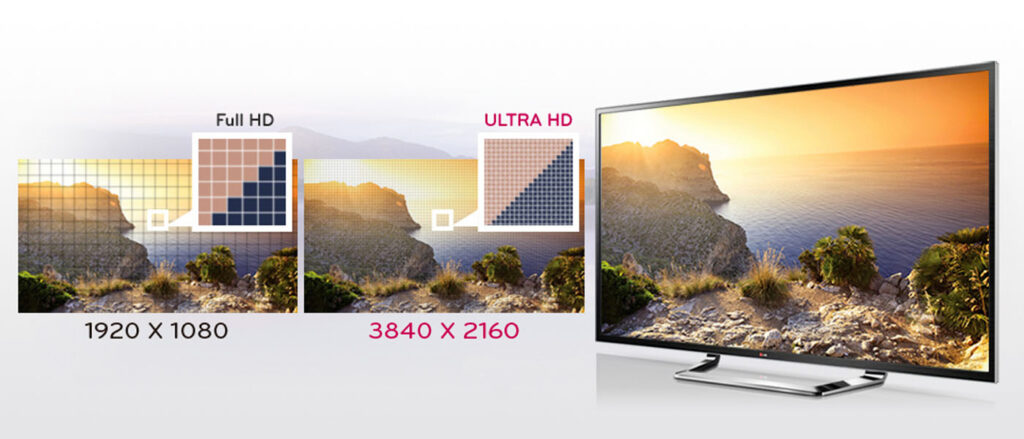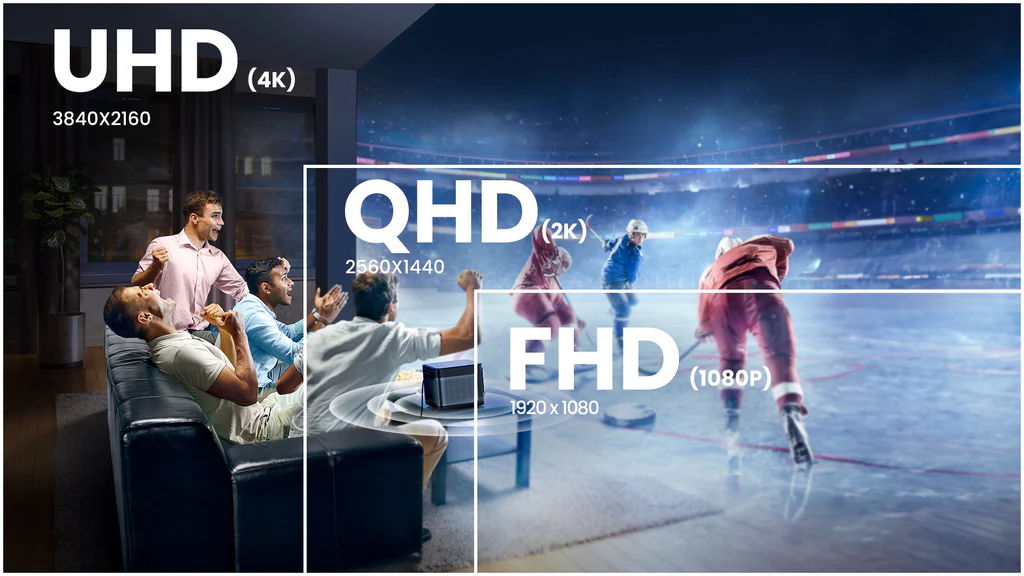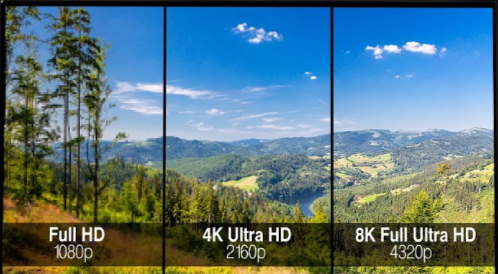In the world of modern televisions, the terms UHD (Ultra High Definition) and 4K are often used interchangeably. Both represent significant advancements in TV resolution technology, promising sharper images and more immersive viewing experiences. However, while many people assume they’re the same, there are subtle differences between UHD and 4K that are worth exploring before deciding which TV is right for you.
This article dives deep into the distinctions between UHD vs 4K TV, explaining their similarities, differences, and what you should consider when choosing between them.
Understanding Resolution: What Do UHD and 4K Mean?
At the heart of the debate between UHD and 4K TV is resolution. Resolution refers to the number of pixels on the screen—tiny dots that make up the images you see. The more pixels a TV has, the clearer and more detailed the image will be.
- 4K: Technically, 4K resolution comes from the cinema industry and is defined as 4096 x 2160 pixels. This resolution is used in professional digital cinema, where the “4K” refers to the approximately 4,000 horizontal pixels.
- UHD (Ultra High Definition): UHD is the consumer-facing term, and it’s slightly different from 4K. A UHD TV has a resolution of 3840 x 2160 pixels, which is exactly twice the number of pixels found in Full HD (1920 x 1080 pixels). This 16:9 aspect ratio is used by most consumer TVs and monitors.
Although the difference in pixel count between 4K and UHD is small, it exists. 4K is a term more specific to cinema, while UHD is the widely accepted standard in consumer electronics. However, many manufacturers label their UHD TVs as 4K, which is why these terms are often confused.
UHD vs 4K TV: Similarities
When comparing UHD vs 4K TVs, it’s essential to understand that they share many characteristics. In most cases, whether your TV is branded as 4K or UHD, the differences won’t be noticeable to the naked eye. Here are the key similarities between the two:
- Increased Resolution: Both UHD and 4K TVs offer significantly higher resolution than Full HD, delivering sharp, detailed images with a greater sense of realism. They can display over 8 million pixels, making them perfect for large-screen TVs where clarity matters most.
- Aspect Ratio: The aspect ratio of UHD and 4K is 16:9, which means you get the same widescreen view that’s ideal for movies, gaming, and other high-definition content.
- HDR (High Dynamic Range) Compatibility: Most UHD and 4K TVs support HDR, a feature that enhances the contrast between light and dark areas of the screen. HDR creates brighter whites, deeper blacks, and a wider range of colors, resulting in a more dynamic and vibrant viewing experience.
- Content Availability: Streaming services like Netflix, Amazon Prime Video, and Disney+ now offer a wide selection of UHD/4K content, making it easier to enjoy the benefits of higher resolution at home. Additionally, 4K Blu-ray players and discs are becoming more common, offering premium visual quality for movie lovers.
UHD vs 4K TV: Key Differences
While the differences between UHD and 4K may seem minor, understanding these nuances can help you make a more informed decision, especially if you’re into high-end displays or professional video editing.
- Resolution Variance: As previously mentioned, the key technical difference is in the pixel count. True 4K refers to 4096 x 2160 pixels, while UHD refers to 3840 x 2160 pixels. While this distinction is mainly relevant in the context of professional cinema, for home entertainment, the difference is typically negligible.
- Industry Use: 4K resolution is primarily used in the film industry, while UHD has become the standard for consumer TVs, broadcasting, and streaming platforms. If you’re buying a TV for personal use, most options labeled as 4K will be UHD in terms of resolution.
- Content Creation: If you’re involved in professional video production, 4K might be the better option due to the extra pixels, which offer more flexibility in editing and cropping without losing detail. For the average viewer, though, UHD provides an excellent balance between cost, quality, and available content.
The Importance of Screen Size
When considering UHD vs 4K TVs, screen size plays a critical role. On smaller TVs (below 50 inches), the difference between UHD and 4K is barely noticeable due to the smaller pixel pitch (the distance between pixels). However, on larger TVs (55 inches and up), the increased pixel count of both UHD and 4K makes a difference in terms of sharpness and clarity.
For example, if you’re watching a movie on a 65-inch screen, the 8 million pixels of a UHD or 4K TV will create a much more immersive and detailed experience compared to a 1080p TV. In this case, upgrading to UHD or 4K is worth it, especially if you enjoy high-definition content.
HDR: A Key Feature in UHD and 4K TVs
Beyond resolution, HDR (High Dynamic Range) is a significant feature that enhances image quality in UHD and 4K TVs. HDR delivers a broader range of colors and higher contrast ratios, improving the overall picture quality. There are different formats of HDR, including HDR10, Dolby Vision, and HDR10+, with each offering varying levels of brightness and color depth.
- HDR10 is the most common format and is supported by most UHD/4K TVs. It enhances picture quality, making it ideal for watching movies, TV shows, and playing video games.
- Dolby Vision offers even better image quality with dynamic metadata that adjusts brightness and contrasts scene by scene, but it is only available on certain high-end TVs.
When comparing UHD vs 4K TVs, always check if the TV supports HDR, as this can make a significant difference in picture quality, especially in dark or brightly lit scenes.
Is UHD or 4K Worth It?
The question of whether upgrading to UHD or 4K TV is worth it depends on your viewing habits, screen size, and content preferences.
- Content Availability: With streaming services, gaming consoles, and Blu-ray players now supporting 4K/UHD content, the availability of high-resolution media is better than ever. If you enjoy streaming 4K content from platforms like Netflix, Hulu, or Amazon Prime, upgrading to a UHD TV is highly recommended.
- Gaming: If you’re a gamer, UHD/4K gaming on consoles like the PlayStation 5 and Xbox Series X provides stunning visuals and smoother gameplay. Higher resolution also enhances the gaming experience by providing crisper images and more immersive environments.
- Future-Proofing: As technology advances, more content is being produced in 4K, and televisions are increasingly supporting higher resolutions. Buying a UHD or 4K TV today ensures that your setup will remain relevant and compatible with future media.
- Viewing Distance: To truly appreciate the difference between UHD and 4K TVs over Full HD, you’ll need to sit at the right distance from your TV. For example, if you have a 65-inch TV, the optimal viewing distance for 4K resolution is about 5-6 feet. Sitting too far from the screen can negate the benefits of the higher resolution.
UHD vs 4K: Which One Should You Choose?
When deciding between UHD vs 4K, the choice ultimately hinges on how you plan to use the TV and what best fits your lifestyle.
For Casual Viewers:
If you’re someone who primarily watches streaming content on platforms like Netflix or Hulu, enjoys sports, or plays console games occasionally, a UHD TV is likely all you need. The visual differences between UHD and 4K resolution, though measurable on paper, are typically imperceptible to the average viewer. Given the widespread availability of UHD content and the excellent balance between price and performance, most consumers will find that a UHD TV provides more than enough clarity and detail for casual viewing. Moreover, UHD TVs come in a wide range of screen sizes, models, and price points, making them accessible to many different budgets.
Why UHD is a good option:
- Affordability: UHD TVs offer stunning picture quality without breaking the bank.
- Broad availability: You can find UHD TVs from every major brand, often bundled with popular features like HDR and smart TV functions.
- Streaming-friendly: Most streaming services already support UHD, so you can enjoy high-definition shows and movies right out of the box.
For Movie Enthusiasts and Professionals:
For cinephiles and those working in video production, a true 4K TV may be a better investment. While UHD is great for the average viewer, 4K delivers a slightly higher pixel count that can make a difference, especially when watching cinema-quality content. The additional pixels can result in more detail, which becomes noticeable on very large screens (65 inches and above) or when you’re viewing the screen from up close.
Additionally, if you’re a content creator, working with high-definition footage, that extra precision in resolution can provide more flexibility during editing and color correction. Professionals working in video production may also prefer a 4K TV for color accuracy and pixel clarity, particularly when working with raw 4K footage. This ensures that what’s on the screen accurately reflects the final output, making 4K ideal for post-production work.
Why 4K is ideal for professionals:
- Detail and clarity: The higher resolution of 4K (4096 x 2160) over UHD (3840 x 2160) may seem minor, but it can make a significant difference when viewing high-end cinematic content.
- Future-proofing: While UHD is standard now, investing in a 4K TV ensures compatibility with emerging content standards, including high-resolution cinema films and professional editing workflows.
- Larger screens: If you plan to buy a large-screen TV (70 inches or more), the additional resolution of 4K becomes more noticeable, delivering an ultra-crisp picture.
Gaming Considerations:
For gamers, both UHD and 4K TVs offer excellent visual quality. However, if you’re playing on consoles like the PlayStation 5 or Xbox Series X, which support 4K gaming, a 4K TV could deliver a more immersive experience, particularly on larger screens. If you’re a casual gamer, a UHD TV will still provide a fantastic experience, but serious gamers looking for the best graphical fidelity might lean toward 4K, especially for fast-paced, visually detailed games.
Final Thoughts:
In the debate of UHD vs 4K, the differences are minor for the average consumer. Most people won’t notice the distinction between UHD and true 4K during everyday use, especially on smaller screens (under 55 inches). UHD is more than sufficient for most viewing needs, offering vibrant colors, sharp images, and widespread compatibility with the content you’ll find on streaming services and Blu-ray discs. Additionally, UHD TVs are more affordable, making them a practical choice for the majority of buyers.
On the other hand, 4K may be the better choice if you’re investing in a high-end home theater setup or working with professional video content. While the extra resolution is only marginal, it offers some advantages in detail and clarity, especially for those looking to future-proof their entertainment system.
Ultimately, the decision boils down to your viewing habits, budget, and personal preferences. If you want the best possible picture quality, enjoy large screens, or are involved in professional video production, opting for 4K could be the right call. For everyone else, UHD will provide an exceptional visual experience without the need for the absolute highest resolution.
When choosing between UHD and 4K TVs, consider your budget, the size of the TV, and the content you’ll be watching most frequently to make an informed decision that fits your lifestyle.




